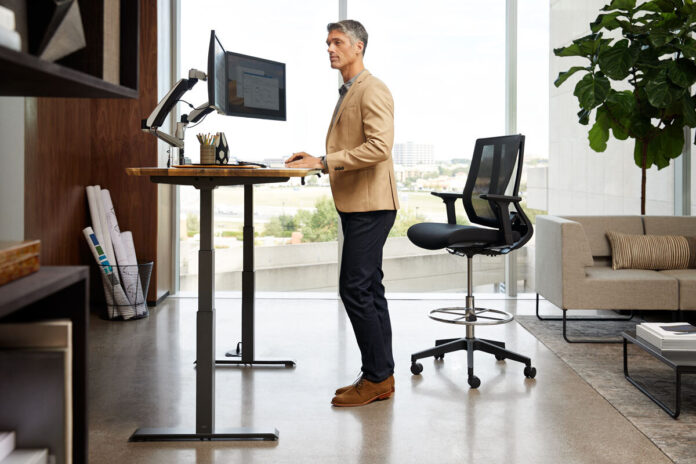The sedentary nature of office work has raised concerns about the health and well-being of employees. However, a potential solution has emerged: standing desks. These innovative workstations offer an alternative to traditional sitting arrangements and aim to break the sedentary cycle. In this article, we explore the benefits of standing desks for office workers, including improved physical health, increased productivity, and overall well-being. By encouraging movement and providing a more active work environment, standing desks have the potential to revolutionize office setups and promote a healthier and more satisfying work experience.
The negative health effects of sitting for long periods of time

A sedentary lifestyle, characterized by extended periods of sitting, has been linked to various adverse health effects. Research indicates that prolonged sitting can increase the risk of obesity, cardiovascular diseases, musculoskeletal problems, and even mental health issues. Reduced physical activity, slower metabolism, poor posture, and impaired blood circulation are among the negative consequences of excessive sitting that can have a cumulative impact on overall well-being.
Recognizing the potential risks associated with prolonged sitting, it becomes imperative to explore strategies for incorporating more movement and activity into daily routines. One solution gaining popularity is the adoption of standing desks. These ergonomic workstations allow individuals to alternate between sitting and standing positions, encouraging more movement during the workday. By promoting better posture and increased physical activity, standing desks offer a potential solution to mitigate the negative health effects of prolonged sitting, contributing to a healthier and more dynamic work environment.
To address the challenges posed by a sedentary lifestyle, individuals can proactively adopt healthier habits and integrate regular breaks, standing or walking intervals, and ergonomic solutions like standing desks into their daily routines. Prioritizing movement and considering ergonomic alternatives can have a positive impact on overall well-being and potentially reduce the health risks associated with prolonged sitting, making it a worthwhile consideration for both office workers and those with desk-bound occupations.
How standing desks can alleviate these health risks

Standing desks have emerged as a potential solution to alleviate the health risks associated with a sedentary lifestyle. These desks allow individuals to switch between sitting and standing positions, encouraging more movement throughout the day. Research suggests that incorporating standing desks into the workplace or home office setup can help improve posture, increase calorie expenditure, promote blood circulation, and reduce the risk of certain health issues such as obesity, cardiovascular diseases, and musculoskeletal problems.
By introducing standing desks, individuals have the opportunity to break free from prolonged sitting and create a more active and dynamic work environment. Standing while working can potentially boost energy levels, enhance focus and concentration, and improve overall productivity. Additionally, standing desks offer the flexibility to adjust the height to suit individual preferences and ergonomic needs, further promoting a healthier and more comfortable working experience.
Integrating standing desks into daily routines presents a practical and effective way to alleviate the health risks associated with excessive sitting. By promoting movement and reducing sedentary behavior, these desks contribute to a more balanced and active lifestyle. However, it is important to note that using standing desks alone may not be a cure-all solution. Combining regular physical activity, proper posture, and ergonomic considerations alongside the use of standing desks can maximize their potential benefits and further mitigate the negative health effects of a sedentary work environment.
How to implement a standing desk into your work routine

Implementing a standing desk into your work routine can have significant benefits for your health and productivity. Here are some steps to help you seamlessly integrate a standing desk into your daily work life:
- Research and choose the right standing desk: Start by exploring different standing desk options available in the market. Consider factors like desk height adjustability, stability, and size to ensure it fits perfectly in your workspace.
- Set up your workspace ergonomically: Position your standing desk at a convenient height, allowing your elbows to be at a 90-degree angle when typing. Ensure that your computer monitor is at eye level to maintain proper posture and reduce strain on your neck.
- Start with gradual transitions: Begin by alternating between sitting and standing periods throughout your workday. Start with shorter standing intervals and gradually increase the duration as your body gets accustomed to the change.
- Find a standing routine that works for you: Experiment with different standing and sitting intervals to find what suits your comfort and productivity levels. Some individuals prefer a 30-minute standing and 30-minute sitting pattern, while others find success with shorter or longer intervals.
- Invest in supportive footwear and a standing mat: Wearing comfortable shoes with proper arch support can make a significant difference when standing for extended periods. Consider using an anti-fatigue mat to reduce strain on your joints and provide cushioning.
- Take regular breaks and incorporate movement: Remember to incorporate regular breaks into your work routine. Use these breaks to stretch, walk around, or engage in light exercises. Movement is essential for maintaining good circulation and preventing stiffness.
- Listen to your body: Pay attention to any discomfort or fatigue while using a standing desk. Adjust your posture, shift your weight, and consider adding additional ergonomic accessories such as an adjustable chair or footrest to enhance your overall comfort.
- Stay hydrated and practice good posture: Hydration is crucial for overall well-being, so ensure you have water readily available at your workstation. Additionally, maintain proper posture by keeping your shoulders relaxed, spine aligned, and core engaged while standing.
By following these steps and making adjustments based on your individual needs, you can effectively implement a standing desk into your work routine. Remember, finding the right balance between sitting and standing, along with incorporating regular movement, will help you reap the maximum benefits of using a standing desk.
Conclusion
In conclusion, standing desks offer a promising solution for office workers seeking to break free from the sedentary cycle that can negatively impact their health and well-being. By providing the option to alternate between sitting and standing positions, these desks promote movement, increase physical activity, and improve posture. The potential benefits of using standing desks include reduced health risks such as obesity, cardiovascular diseases, and musculoskeletal problems, along with increased energy levels, focus, and productivity.
Embracing standing desks as part of the office setup encourages a healthier and more dynamic work environment, contributing to the overall well-being of employees. However, it is important to note that the successful implementation of standing desks requires proper ergonomic considerations, gradual transitions, and a personalized approach.
By adopting a balanced approach that combines standing with regular breaks and movement, office workers can harness the potential of standing desks to enhance their work experience and prioritize their long-term health.









